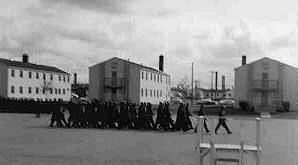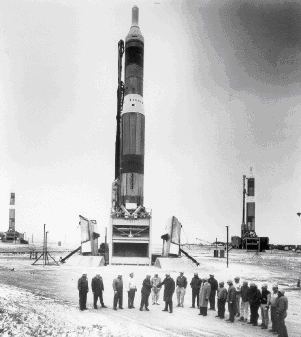| SAC Bases: Lowry Force Base |
|
|
|
Early History
Lowry Field was originally located near East 38th
Avenue and Dahlia Street. It was named after Denver native, US Army
Lt. Francis B. Lowry, who was killed in action during World War I. In 1937,
President Roosevelt authorized funds to relocate Lowry field to its final
site near East 6th Avenue and Quebec Street. The base started its training
mission in earnest the following year. World War II caused Lowry to greatly
expand it facilities in order to train bomber aircrews along with a large
number of other technical specialists. |
Training
Center
After the war, Lowry continued to train
technicians for all branches of the US military. The 59,814 acre Lowry
Bombing Range operated from July to December of 1952. It was used
by the local Navy, Lowry Air Force Base, and the Air National Guard for
practicing bombing and strafing missions and for demolition of unusable
Air Force munitions.
On June 7, 1951, Lowry’s 3415th Technical Training Wing
formed a Guided Missile Department. It taught courses in guidance,
control, and propulsion for such systems as Matador, Falcon, Rascal,
Snark, and Navaho. By 1962, the Department of Missile Training was
providing the Air Force with over 1,000 trained missile specialists per
year.
Over the years, thousands of airmen trained at
Lowery. |
 |
|
Lowry Barracks, circa
1951 |
|
|
From
1953 to 1955, Lowry became President Dwight D. Eisenhower's "Summer White
House" from which he conducted affairs of state while Mamie Eisenhower, a
Denver native, visited with family. In 1955, the United States Air
Force Academy was established at Lowry AFB pending construction of its
facilities in Colorado Springs. The academy remained in
operation at Lowry until 1958.
Titan Missile Base
On March 13, 1958, the Air Force Ballistic
Committee approved the selection of Lowry to be the first Titan I ICBM base.
The launch sites were to be located on the bombing range east of Denver.
This was conveniently close to the Titan I manufacturer, the Martin Company
(now Lockheed Martin) located in Littleton, Colorado. |
|
|
Deployment of the
missiles entailed a 3 x 3 configuration, meaning that each of the three
complexes had three silos grouped in close proximity to a manned launch
control facility. In September 1958, construction began on Titan I Missile
Complex 1A, the first of six complexes constructed within an 18 mile radius.
The excavation was started in May 1959 using an open cut method with depths
ranging from 38' to 72'. The missile silo shafts were excavated by mining
crews to a depth of 163'. The construction of the underground facilities
were of reinforced concrete and structural steel with steel lined tunnels.
An unusual requirement was the blast-proofing of elements incorporated into
the work with the major mechanical and electrical elements shock-mounted to
withstand all explosions except a direct hit. The heavy construction phase
was completed on 4 June 1961. The complex was made up of three missile
launching silos.
The Omaha District of the Army Corps of Engineers
contracted a joint venture led by Morrison-Knudsen of Boise, Idaho, to
construct the silos. A 144-day steel strike in 1959 caused delays and forced
Morrison-Knudsen to resort to winter concreting. Despite this problem and
others caused by constant design modifications, Morrison-Knudsen completed
the project on time with the lowest construction costs of any ICBM base in
the country at the time. Fairly smooth management-labor relations
contributed to the success. The project also maintained the best safety
record in the missile construction program up until that time. Use of a
safety net was credited with saving many lives. Three workers did die during
the project, although one was the result of a motor vehicle accident that
occurred off site. |
 |
|
First Titan I Missile |
|
The 703rd Strategic Missile Wing (ICBM-Titan ) was established on
September 5, 1958. It was activated at Lowery on Sept. 25,
1958 and assigned to the 1st Missile Division, Fifteenth Air Force.
It was a very short-lived wing.
It trained in the operation of the Titan intercontinental ballistic
missile and became partially operational on December 10, 1958, but before it could become fully operational, it was replaced by the
451st Strategic Missile Wing.
The 451st Strategic Missile Wing (ICBM-Titan) was
activated on April 26, 1961 and replaced the 703rd in July. The first missile complex was accepted on April 18, 1962.
The Titan I was soon replaced by the more advanced Titan II, which was
deployed at other locations. On November 19, 1964, Defense
Secretary McNamara announced the phase-out of remaining first-generation
Atlas and Titan I missiles by the end of June 1965. This objective was
met; on June 25, 1965, the 724th SMS and 725th SMS were inactivated. The
451st went off alert status on March 26, 1965 and began phasing down.
The last missile was removed from Lowry on April 14, 1965. The
451st was discontinued and inactivated June 25, 1965.
Although the strategic missiles were gone,
missile training remained a vital component of Lowry’s mission. In 1972,
the 3415th Technical School became the USAF School of Applied Aerospace
Sciences with missile training continuing within the Department of
Aerospace Munitions Training. In 1978, this department would be
redesignated the 3460th Training Group.
The Lowry AFB Titan I Missile Complex IA is located
approximately 15 miles southeast of Denver, Colorado. It is
bounded by a chain-link fence. |
|
Recent History
Due to the close proximity of the residential
area around Lowry and the increase in the number of high performance jet
aircraft accidents at the base, flight operations at Lowry ceased in 1966.
In 1976 the US Air Force Accounting and Finance Center moved from its old
location near East 40th Avenue and York Street to newly built facilities at
the southwest corner of the base.
In 1980, Lowry Technical Training Center acquired
a B-52D from Davis-Monthan AFB, Arizona, and stabilized another B-52 on base
for use in training crews to load Air Launched Cruise Missiles (ALCMs) and
Short Range Air Missiles (SRAMs). Although Chanute AFB, Illinois, served as
the primary training center for the Peacekeeper ICBM, Lowry supported
training for this strategic missile by providing maintenance and repair
training for the Peacekeepers’ reentry vehicle at a state-of-the-art
facility opened in 1985. In October 1986 ATC initiated an
undergraduate space training program at Lowry AFB, CO, providing a basic
preparation for space operational assignments. The Maintenance Officer's
Nuclear Munitions Course was also conducted at the Lowry AFB Technical
Training Center. Comptroller, transportation, and intelligence training
moved to Sheppard AFB from Lowry AFB in the fall of 1954. In the late 1980s
intelligence training consolidation brought general intelligence training
from Lowry AFB to Goodfellow AFB.
In 1993 it was announced that Lowry would be closed as part
of cost reduction measures being taken by the US military. On 12 April 1993
the Air Staff approved moving small missile maintenance training from Lowry
AFB to Vandenberg AFB, California, where it would be consolidated with large
missile maintenance training. The base officially closed October 1, 1994.
Lowry is still an active air force base, but has
become an administrative center. It is home of the Reserve Personnel
Center, which is charged with providing essential services and
administration for the nearly half million women and men of the Air Reserve
components in support of the Air Force mission. The center also maintains
the master personnel records of all Air National Guard and Air Force Reserve
members. The Defense Finance Accounting Service is also located at Lowry. |
|
